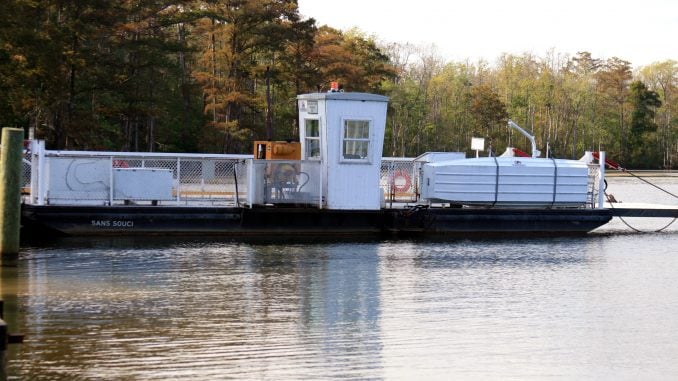
A cable spanning the width of the river keeps the ferry — called the Sans Souci — from floating downstream.
But its French name (pronounced sahn soo-see) tells travelers what to expect: “No worries.”
A ferry has operated here since the 1800s, connecting small communities and farms on both sides of the river. The state took it over in the 1930s. The vessel is one of three cable ferries in North Carolina.
Mainly farmers, hunters and tourists cross the waterway these days. Some people go to the church or visit family on the other side.
“We probably get maybe 10 cars a day,” said Erriod Watson, who has operated the ferry for six years. In the summer, traffic might be double what it is now, he said, revving the engine. The force was barely fast enough to keep up with a fishing skiff.
The ferry came back into service last month after being gone for about a year. It was completely overhauled for $100,000.
The crossing is roughly a 20-minute car ride from town. On one side, Woodard Road winds 10 miles from U.S. 17 outside Windsor, cutting through farmland and woods where houses are a half-mile apart. Oak tree branches hang over the narrow pavement, and hawks peer down from tree-top perches.
The boat lands at the end of a narrow dirt passage between the river bank and the swamp. Heavy rains make it hard to distinguish the swollen waterway from the road.
The dirt path connects to San Souci Road, which continues north past a cluster of modest houses and mobile homes. It’s the largest community for miles on either side.
“I would love it if it ran every day,” said Roberta Reason, who lives less than a mile from the ferry.
Reason was headed for a doctor’s appointment in Williamston. She has to travel an extra 20 miles on main roads when the boat isn’t running.
Trips are spotty enough that the state installed flashing lights at Woodard and Sans Souci roads. If the light is blinking, the ferry’s operating.
“People needed some notification before going all the way down there,” said James W. “Russ” Russell Jr., co-owner of Bunn’s Barbecue in Windsor. “If it wasn’t running, you would cuss like a sailor.”
Between trips, the operator stays on the Woodard Road side in a work station about the size of a backyard shed. Across the river, a traveler pulls up to the crossing arm at the ramp and blows the horn. When Watson hears it, he cranks up the engine and cruises over.
The ferry was busier decades ago.
Moonshiners used it during Prohibition and farmers once depended on it, said Lewis Hoggard, director of the Windsor-Bertie County Chamber of Commerce.
“Back in the day, you could take a tractor across,” he said. “Now everything is so big you can’t do that.”
Hoggard frequently gets calls about the ferry, especially after media attention. People have been known to sidetrack more than 60 miles from Interstate 95 to ride the Sans Souci. They tell him they have never been on anything like it.
Quoting from a handout the chamber published about the trip, he says: “Well, you’ve been missing something.”




